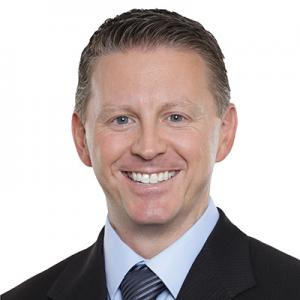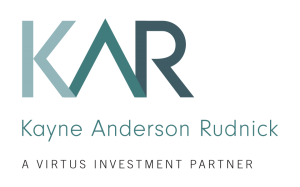
Chris Armbruster, CFA
Portfolio Manager and Senior Research Analyst
Kayne Anderson Rudnick
KAR portfolio manager Chris Armbruster discusses the performance of mid-cap growth equities in the first quarter, the largest stock contributors and detractors in the KAR Mid-Cap Growth strategy, and expectations for earnings growth.
Listen Now
Transcript
BEN FALCONE: Hello, this is Ben Falcone, managing director with Kayne Anderson Rudnick, and with me today, I have Chris Armbruster, portfolio manager of the KAR Mid-Cap Growth Strategy. Welcome, Chris.
Chris, market returns were broadly positive again in the first quarter even though many issues such as clarity on future Fed movements, geopolitical risk, the upcoming presidential election. Even though heavily debated, they still remain. Also, amidst the talk about this potential broadening out of returns, the first quarter really reverted right back to seeing concentrated returns in the S&P leading the markets while mid-caps were a solid second, and then a fewer smaller AI-related growth companies driving returns for the broader small-cap index. Can you provide our listeners with your perspective on markets for the start of 2024?
CHRIS ARMBRUSTER: Late last year, the chairman of the Federal Reserve announced plans to reduce short-term interest rates by 75 basis points in 2024. Now referred to as the “Powell pivot,” this plan came on the heels of signs that inflation was coming under control. Since then, inflation has remained stubbornly elevated and overall economic activity including unemployment has remained robust. The futures market is now pricing in something less than the 75 basis points guidance from the Fed. The higher-for-longer paradigm generally leads to growth being more scarce and naturally favors strong secular growers like the Magnificent Seven and AI-related growth companies.
Over time, this too will normalize and success for companies, especially high-quality ones, will again depend on the micro more than the macro. We would actually argue that, on average, companies have adapted to this new reality. One high-level data point in support would be that the S&P earnings growth dramatically accelerated during the second half of 2023 versus the first half. Aided by relatively strong demand, companies have taken steps to mitigate inflation in their supply chain and raise prices where prudent to combat residual rising costs.
BEN FALCONE: Chris, can you discuss a few of the portfolio holdings that were key contributors and detractors to performance for the first quarter?
CHRIS ARMBRUSTER: The top five contributors to the Mid-Cap Growth portfolio this quarter were functional energy drink maker, Celsius, energy exploration and production company Diamondback, electrification enabler Amphenol, FICO score creator Fair Isaac, and fresh pet food pioneer Freshpet.*
The name we would like to spend a little more time with this quarter is Freshpet. Fresh pet food is taking share from traditional pet food as owners are willing to pay a premium for better quality products and longer lives for their furry friends. From our perspective, Freshpet has differentiated itself in the industry with its selection of refrigerated foods that are stocked in fridges installed and maintained by the company at retailers. Normally in high traffic areas, these fridges are branded, carry solely Freshpet merchandise, and typically are the only refrigerated pet food offering in the store. In our view, this distribution allows the company to price the offering below competitors, and consumption has shown to be sticky with repurchase rates over 70%.
Early in the pandemic, pet adoption surged as people who were in lockdown saw a perfect opportunity to housebreak a new pet. Sales accelerated in 2021 and even part of 2022, but the management team had operational problem after operational problem trying to run the growing company. Manufacturing issues were caused by delays in sourcing parts and equipment delays in actually getting equipment delivered due to shipping constraints and further delays installing that very same equipment. Covid affected the labor required to build new production capacity and the labor needed to run that capacity effectively. This all led to unfilled orders significant out of stocks, consumers needing to trial and consume other brands, and a reluctance of retailers to accept new fridges.
We believe we managed our position accordingly, trimming it twice. The only thing that prevented us from exiting the position entirely was what we felt was a strong product market fit that the company enjoyed despite all of its operational struggles. An activist shareholder felt the same and spearheaded a plan to improve oversight of the company by using its stake to appoint two new board members to the board of directors and influencing the appointment of a new CFO in December of 2022.
Not only has sales growth remained strong but profitability – a long held point of contention for detractors of the company – has meaningfully inflected. Margins have moved higher with gross and operating margins up year over year in the fourth quarter of 2023. As the fundamentals came back, we added to our position in late 2023 and believe the company might finally be ready to generate profitable growth in 2024.
The bottom five detractors from the Mid-Cap Growth portfolio for the quarter were electronic fixed-income exchange operator MarketAxess, personal line insurance broker Goosehead, animal health giant Zoetis, online bill provider BILL.com, and next-generation database creator Mongo DB.
The detractor we wanted to focus on this quarter is MarketAxess. Most major asset classes have moved to fully electronic trading. In most cases, one or two platforms dominate each asset class as advantaged electronic trading has a network effect that reduces costs and tightens spreads.
However, adoption of digital trading in fixed-income markets has not been the smooth upward slope that one would expect given all of its advantages – liquidity, price, discovery, execution, attribution, et cetera. It is true that electronic trading has found its place in the market. But MarketAxess launched its platform in 2000 and after nearly a quarter of a century, only 40% of investment grade debt and about a third of high yield bonds trade electronically. Over the years, MarketAxess has blamed this on a number of factors like issuance rate levels, the slope of the curve, and spreads. It seemed that at every turn, there was some external factor preventing the company from realizing its true potential.
The more we watched the industry, we came to realize some important things about this business. There are a number of structural things that will prevent this market from ever fully embracing electronic trading. Namely the vast majority of trades are small and the number of individual securities is vast, meaning the liquidity on the platform will never be as deep as that of other markets. Additionally, it has proven too costly for larger volumes to go electronic because of the information leakage, which is especially true of off-the-run securities.
And finally, a competitor has been beating MarketAxess at its own game, starting in the Treasury part of the fixed-income universe, but quickly realizing its platform was just as well positioned as MarketAxess’s for handling high-grade U.S. debt, historically, MarketAxess’s most important and dominant business. This competitor has grown its share dramatically, and while MarketAxess insists it is not coming at its own expense, MarketAxess’s share has declined in recent quarters.
While we think MarketAxess was a great growth story for over a decade following the Great Financial Crisis, we believe it has hit a growth wall, and in its current form, with the current level of competition, won't be able to achieve the dominant share of a fully electronic trading market like we had believed in the past. We finally closed out the remainder of our position and moved on to other higher-quality growth opportunities in the quarter.
BEN FALCONE: Chris, we know that longer-term earnings drive performance. Can you speak about this particular strategy and what you're seeing in terms of current earnings growth, as well as your longer-term expectations?
CHRIS ARMBRUSTER: Before the pandemic and to some extent in the years right afterwards, many growth companies were rewarded for a grow-at-all-costs mentality. Capital was inexpensive and companies could raise huge sums of money, which they could then burn through to try to maximize their growth runway. The collapse of Silicon Valley Bank and the rise in interest rates have changed the landscape dramatically. Now the path to profitability for those not yet there is of paramount concern. We have invested in multiple companies that were artificially depressing their profitability in the name of growth. Many of those have revised their growth algorithm to include profitability and have generated expanding margins and transformed their profitability from our perspective. This change leaves these companies on firmer financial footing that we always believe they could achieve, but importantly, we do not believe it has compromised their ability to achieve their ultimate potential.
BEN FALCONE: Chris, as always, thanks for taking the time to provide your insight to our KayneCast listeners.
*Celsius, Diamondback, Amphenol, Fair Isaac, and Freshpet were the top 5 contributors in the KAR Mid Cap Core SMA. Celsius, Diamondback, Amphenol, Freshpet, and The Trade Desk were the top 5 contributors in the Virtus KAR Mid-Cap Core Fund, and Fair Isaac was #6.
This information is being provided by Kayne Anderson Rudnick Investment Management, LLC (“KAR”) for illustrative purposes only. Information contained in this material is not intended by KAR to be interpreted as investment advice, a recommendation or solicitation to purchase securities, or a recommendation for a particular course of action and has not been updated since the date of the material, and KAR does not undertake to update the information presented should it change. This information is based on KAR’s opinions at the time of the recording of this material and are subject to change based on market activity. There is no guarantee that any forecasts made will come to pass. KAR makes no warranty as to the accuracy or reliability of the information contained herein.
Investing is subject to risk, including the risk of possible loss of principal.
Past performance is no guarantee of future results.
3539278
